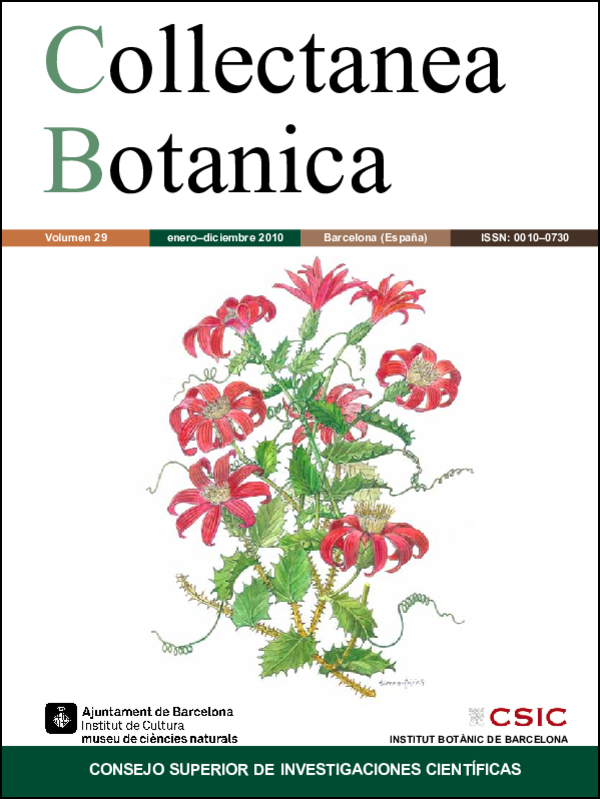New habitats, new menaces: Centaurea x kleinii (C. moncktonii x C. solstitialis), a new hybrid species between two alien weeds
DOI:
https://doi.org/10.3989/collectbot.2010.v29.002Keywords:
Centaurea moncktonii, Centaurea solstitialis, hybridization, invaders, OregonAbstract
Anthropic alteration of habitat opens the door to the cohabitation of imported species that in their native range would never coexist. Centaurea solstitialis and Centaurea moncktonii are two invasive species whose natural distributions in Eurasia do not overlap. After introduction in North America, invasive spread led to overlapping distributions. Although the environmental requirements differ between the two species, the close proximity of diverse habitats (within pollinator range) has resulted in several cases of natural hybridization between the two. The result of the cross between these two distantly related species is a sterile perennial. Many of its characteristics are intermediate between its parents, but morphologically it is closer to Centaurea moncktonii (probably the maternal parent, and itself of hybrid origin). The plant could possibly become an invasive weed through clonal reproduction. The apparent maternal parent, which the hybrid may more closely resemble physiologically as well as morphologically, is a wellknown creeping weed in alpine pastures throughout Europe.
Downloads
References
Blair, A. C. & Hufbauer, R. A. 2009. Hybridization and invasion: one of North America’s most devastating invasive plants shows evidence for a history of interspecific hybridization. Evol. Appl. 3: 40-51. doi:10.1111/j.1752-4571.2009.00097.x
Couderc, M. 1975. Origine hybride du Crupina intermedia Briq. et Cavill. Colloq. Int. C.N.R.S. 235: 531-536.
Dostál, J. 1976. Centaurea L. In: Tutin, T. G., Heywood, V. H., Burges, N. A., Moore, D. M., Valentine, D. H., Walters, S. M. & Webb, D. A. (Eds.), Flora Europaea 4. Cambridge University Press, London, New York and Melbourne: 254-301.
Gáyer, G. 1909. Vier neue Centaureen der Flora von Ungarn. Magyar Bot. Lapok. 8: 58-61.
Garcia-Jacas, N., Uysal, T., Romashchenko, K., Suárez-Santiago, V., Ertu.rul, K. & Susanna, A. 2006. Centaurea revisited: a molecular survey of the Jacea group. Ann. Bot. (Oxford) 98: 741-753.
Howell, J. T. 1959. Distributional data on weedy thistles in western North America. Leafl. West. Bot. 9: 17-32.
Johnson, D., Vandenkoornhuyse P. J., Leake, J. R., Gilbert, L., Booth, R. E, Grime, J. P., Young, P. W. & Read, D. J. 2003. Plant communities affect arbuscular mycorrhizal fungal diversity and community composition in grassland microcosms. New Phytol. 161: 503-515. doi:10.1046/j.1469-8137.2003.00938.x
Keil, D. J. & Ochsmann, J. 2006. Centaurea. In: Flora of North America Editorial Committee (Eds.), Flora of North America North of Mexico. Oxford University Press, New York: 181-194.
Marrs, R. A., Hufbauer, R. A., Bogdanowicz, S. M. & Sforza, R. 2006. Nine polymorphic microsatellite markers in Centaurea stoebe L. [subspecies C. s. stoebe and C. s. micranthos (S. G. Gmelin ex Gugler) Hayek] and C. diffusa Lam. (Asteraceae). Molec. Ecol. Notes 6: 897-899. doi:10.1111/j.1471-8286.2006.01391.x
Marsden-Jones, E. M. & Turrill, W. B. 1954. British knapweeds. A study in synthetic taxonomy. Ray Society, London.
Ochsmann, J. 2000. Morphologische und molekularsystematische Untersuchungen an der Centaurea stoebe L.-Gruppe (Asteraceae-Cardueae) in Europa. Dissertationes Botanicae 324. J. Cramer, Vaduz.
Ockendon, D. J. 1975. Centaurea. In: Stace, C. A. (Ed.), Hybridization and the flora of the British Islands. Academic Press, London: 427-428.
Roché, B. F., Jr. & Talbott, C. J. 1986. The collection history of Centaureas found in Washington state. Ag. Res. Ctr. Bull. XB0978, Washington State University, Pullman.
Roché, B. F., Jr. & Roché, C. T. 1991a. Identification, introduction, distribution, ecology, and economics of Centaurea species. In: James, L. F., Evans, J. O., Ralphs, M. E. & Childs, R. D. (Eds.), Noxious range weeds. Westview, Boulder: 274-291.
Roché, C. T. & Roché, B. F., Jr. 1991b. Meadow knapweed invasion in the Pacific Northwest, U.S.A., and British Columbia, Canada. Northw. Sci. 65: 53-61.
Roché, C. T. & Thill, D. C. 2001. Biology of common crupina and yellow starthistle, two Mediterranean winter annual invaders in western North America. Weed Sci. 49: 439-447. doi:10.1614/0043-1745(2001)049[0439:BOCCAY]2.0.CO;2
Roché, C. T. & Johnson, D. E. 2003. Meadow Knapweed (Centaurea pratensis Thuill.). PNW Ext. Bull. 0566. Oregon State University, Corvallis.
Rösch, M. 1998. The history of crops and crop weeds in southwestern Germany from the Neolithic period to modern times, as shown by archaeobotanical evidence. Veg. Hist. Archaeobot. 7: 109-125. doi:10.1007/BF01373928
Thomsen, C. D., Williams, W. A., Vayssieres, M. P., Turner, C. E. & Lanini, W. T. 1996. Yellow starthistle biology and control. University of California Publication 21541, Oakland.
Wagenitz, G. 1987. Centaurea. In: Hegi, G. (Ed.), Illustrierte Flora von Mittel-Europa VI 4. Verlag Paul Parey, Berling and Hamburg: 934-985.
Watanabe, K. 2010. Index to chromosome numbers in Asteraceae. Retrieved Jun 10, 2010, from http://www-asteraceae.cla.kobe-u.ac.jp/index.htmlm.
Downloads
Published
How to Cite
Issue
Section
License
Copyright (c) 2010 Consejo Superior de Investigaciones Científicas (CSIC)

This work is licensed under a Creative Commons Attribution 4.0 International License.
© CSIC. Manuscripts published in both the print and online versions of this journal are the property of the Consejo Superior de Investigaciones Científicas, and quoting this source is a requirement for any partial or full reproduction.
All contents of this electronic edition, except where otherwise noted, are distributed under a Creative Commons Attribution 4.0 International (CC BY 4.0) licence. You may read the basic information and the legal text of the licence. The indication of the CC BY 4.0 licence must be expressly stated in this way when necessary.
Self-archiving in repositories, personal webpages or similar, of any version other than the final version of the work produced by the publisher, is not allowed.














